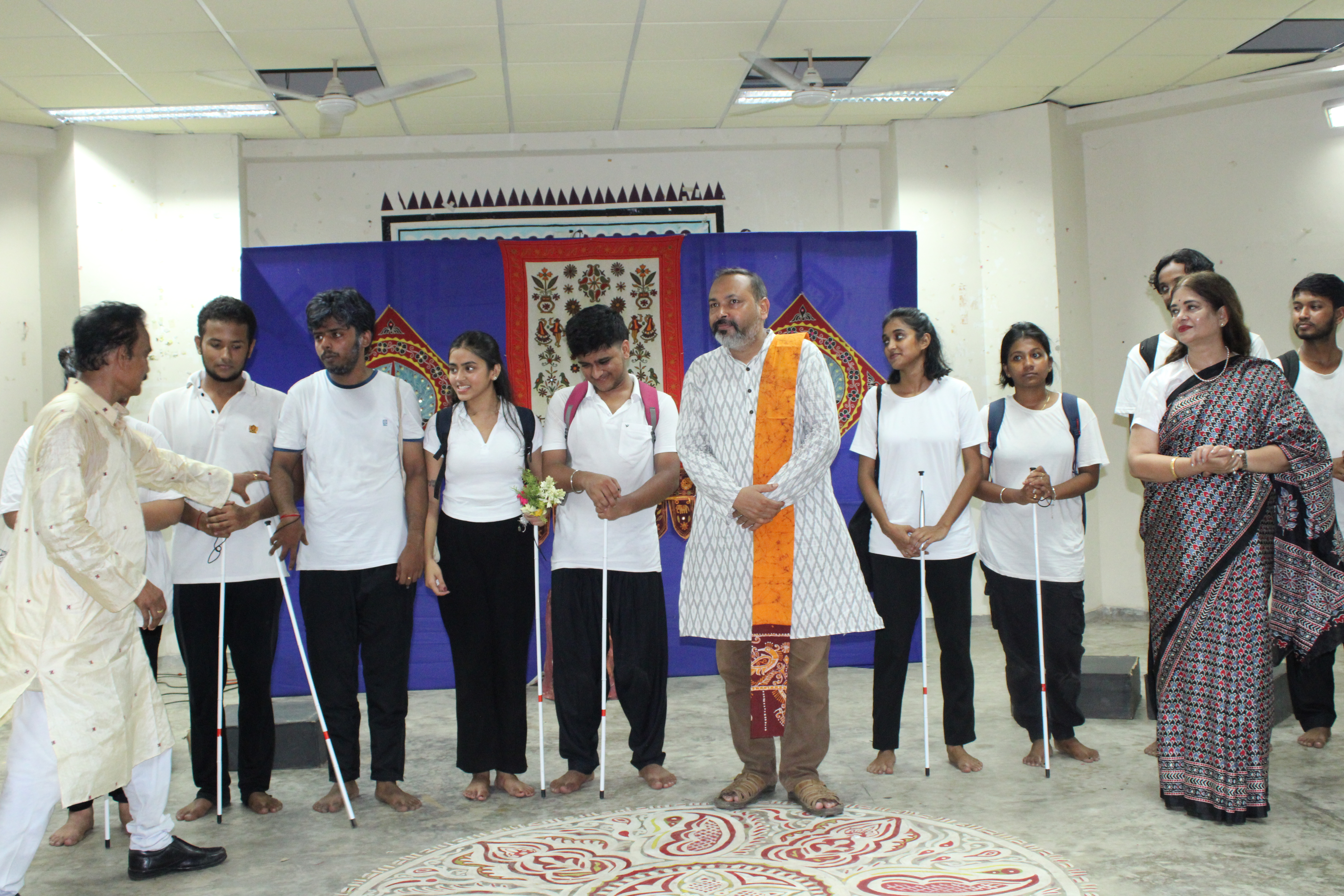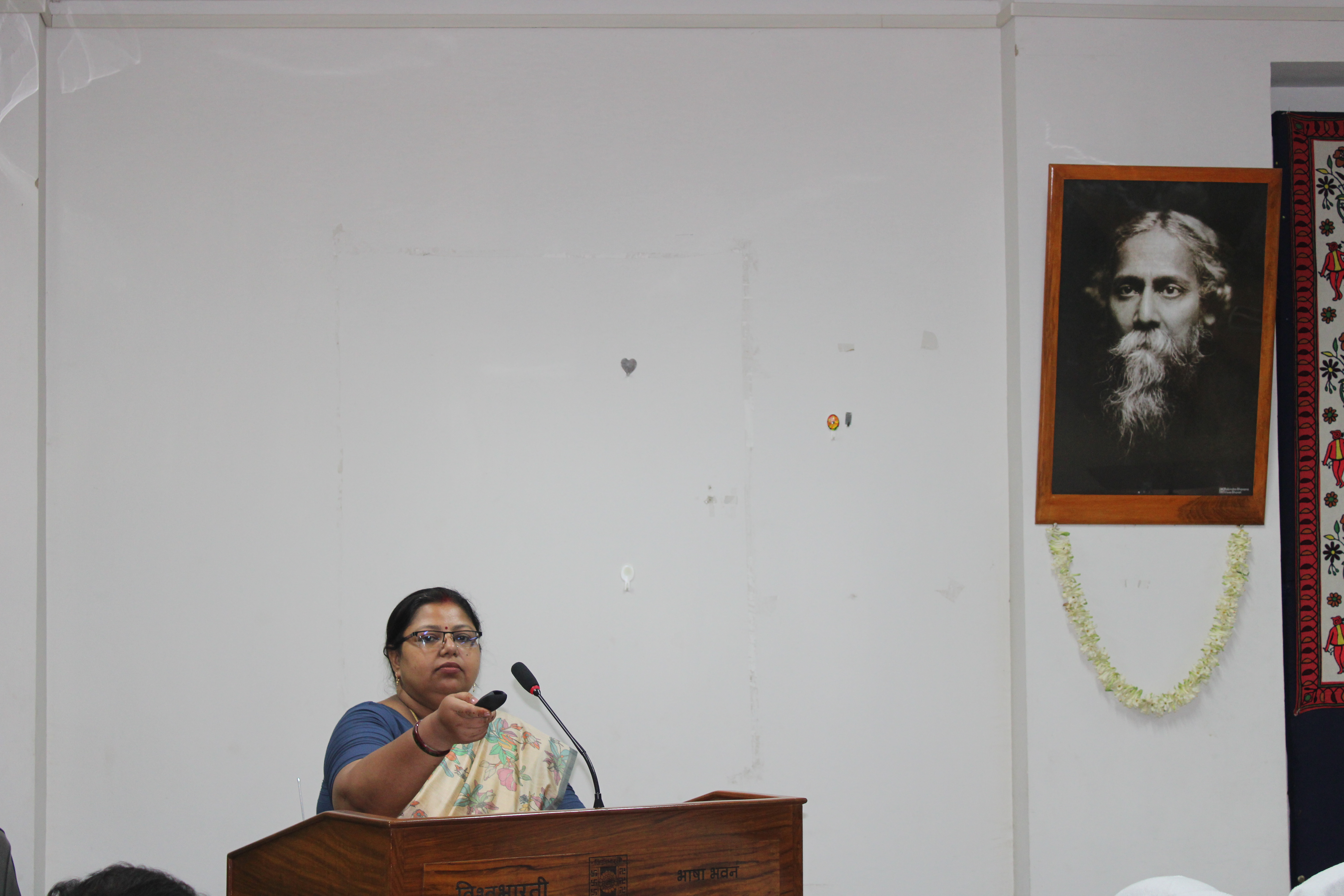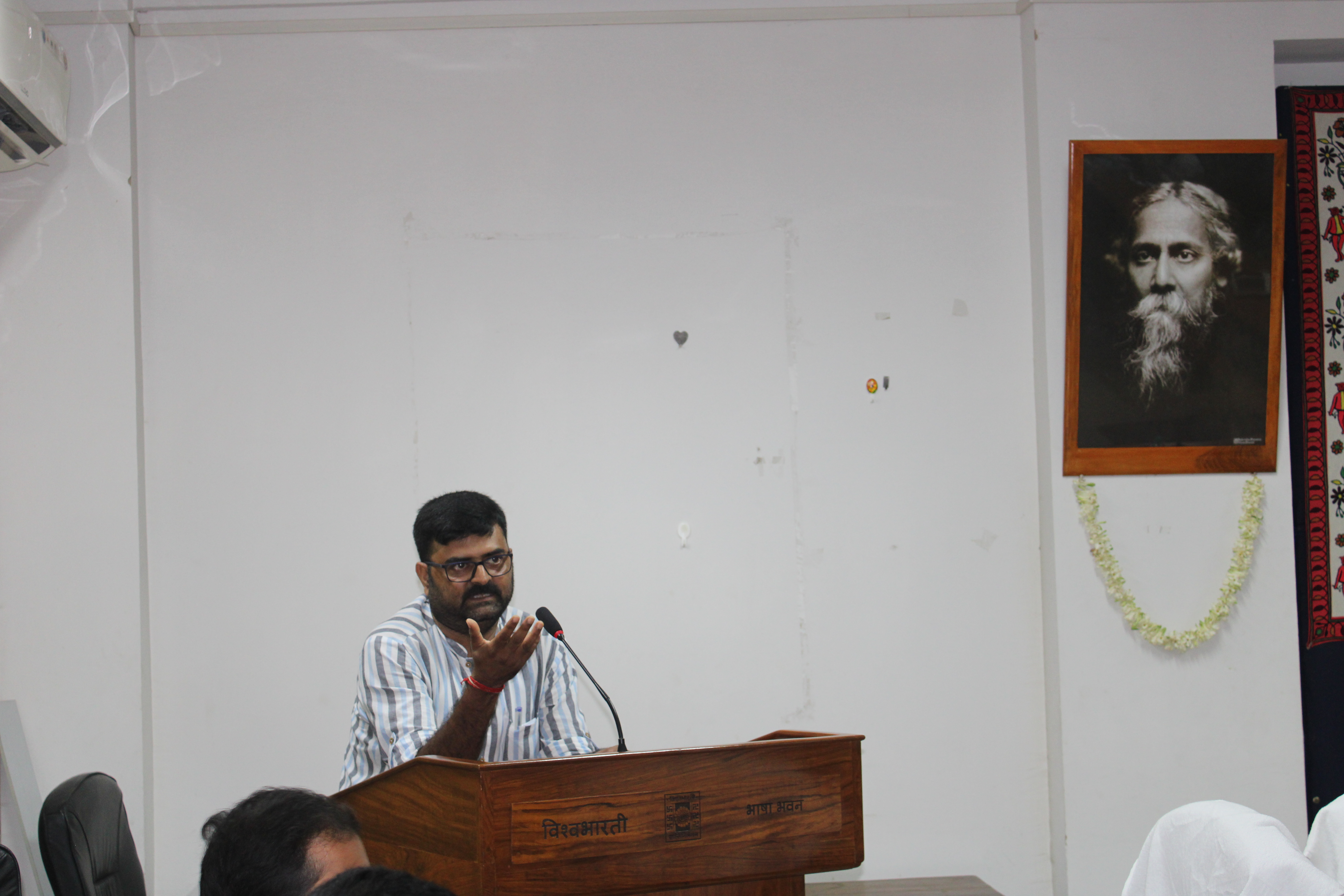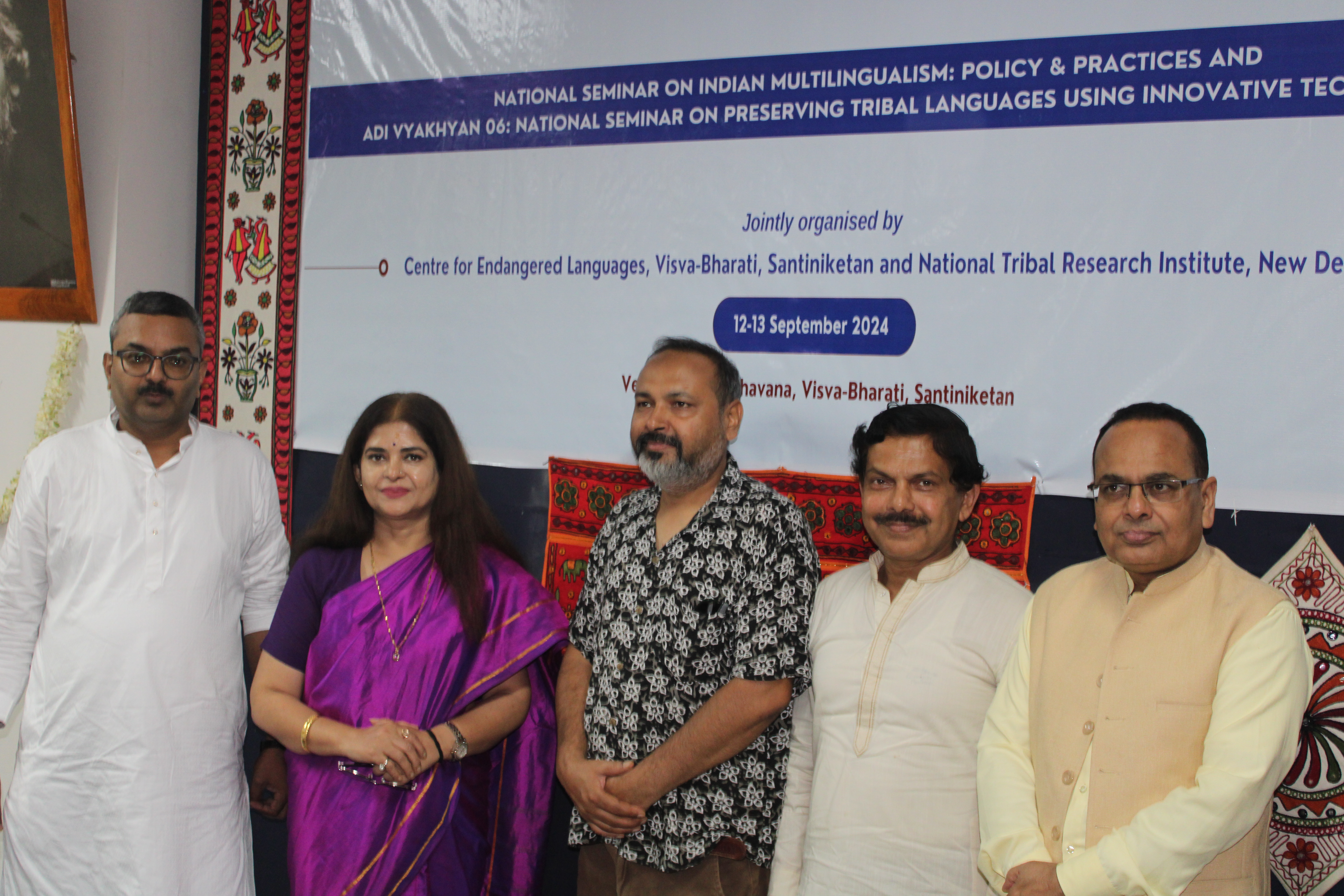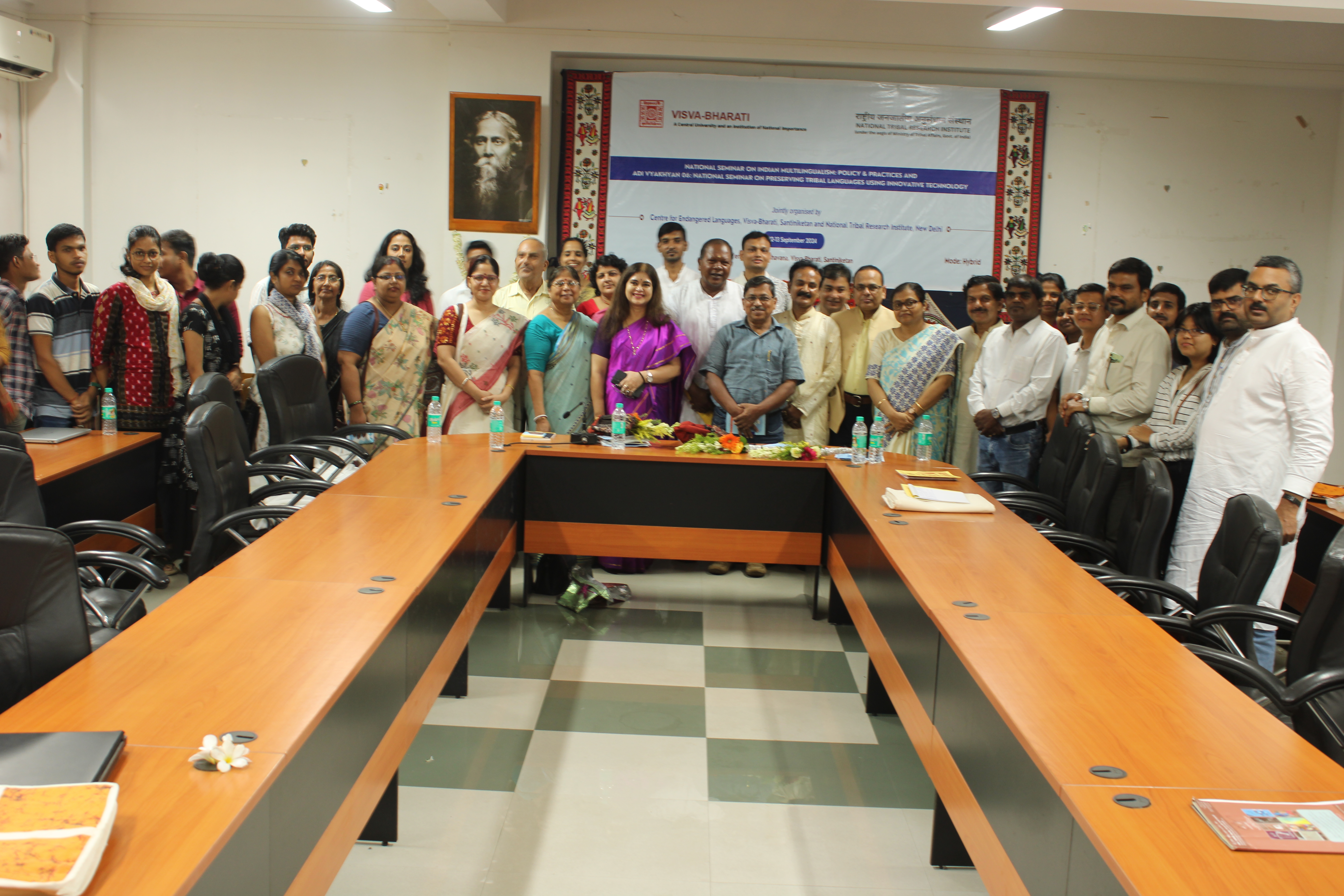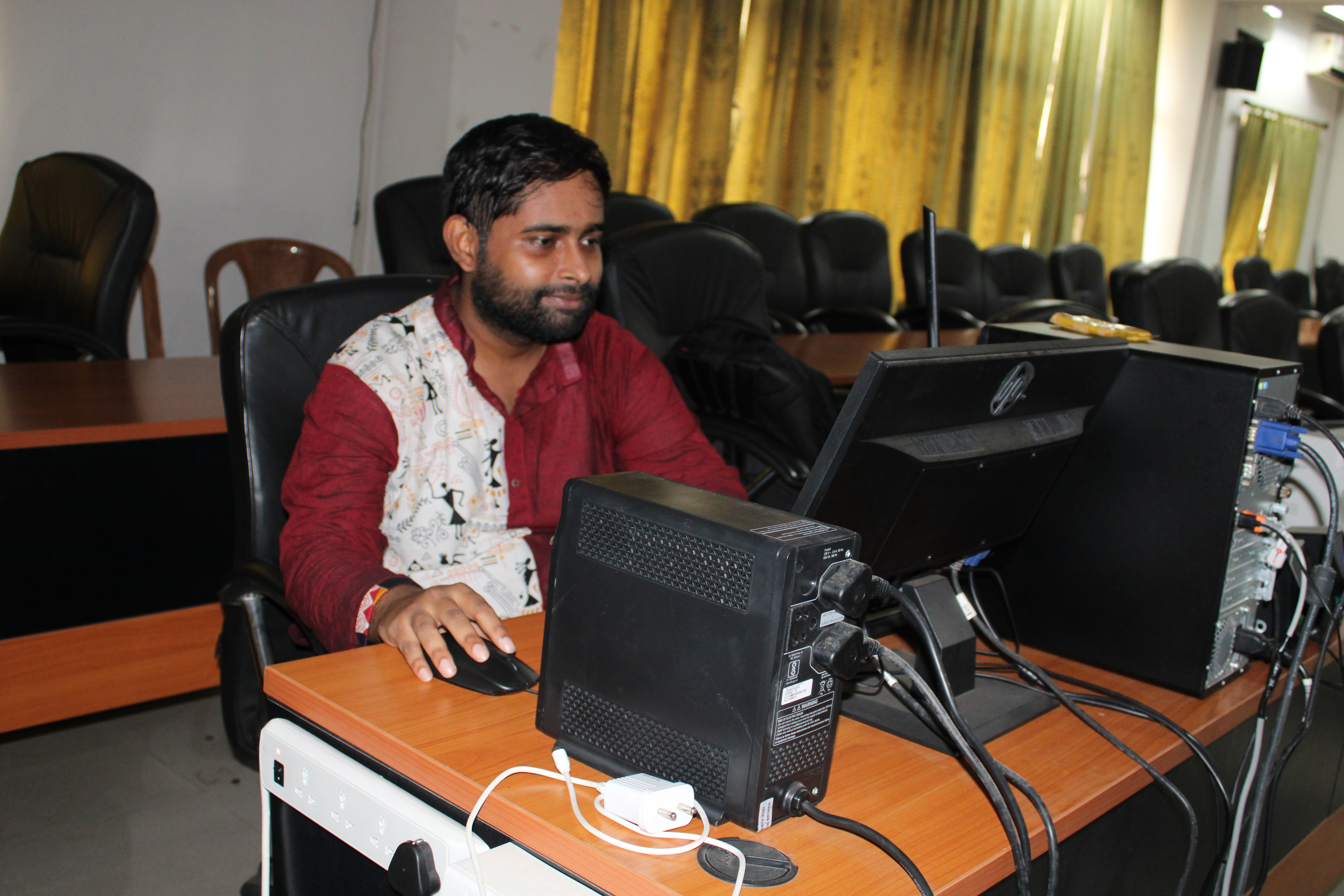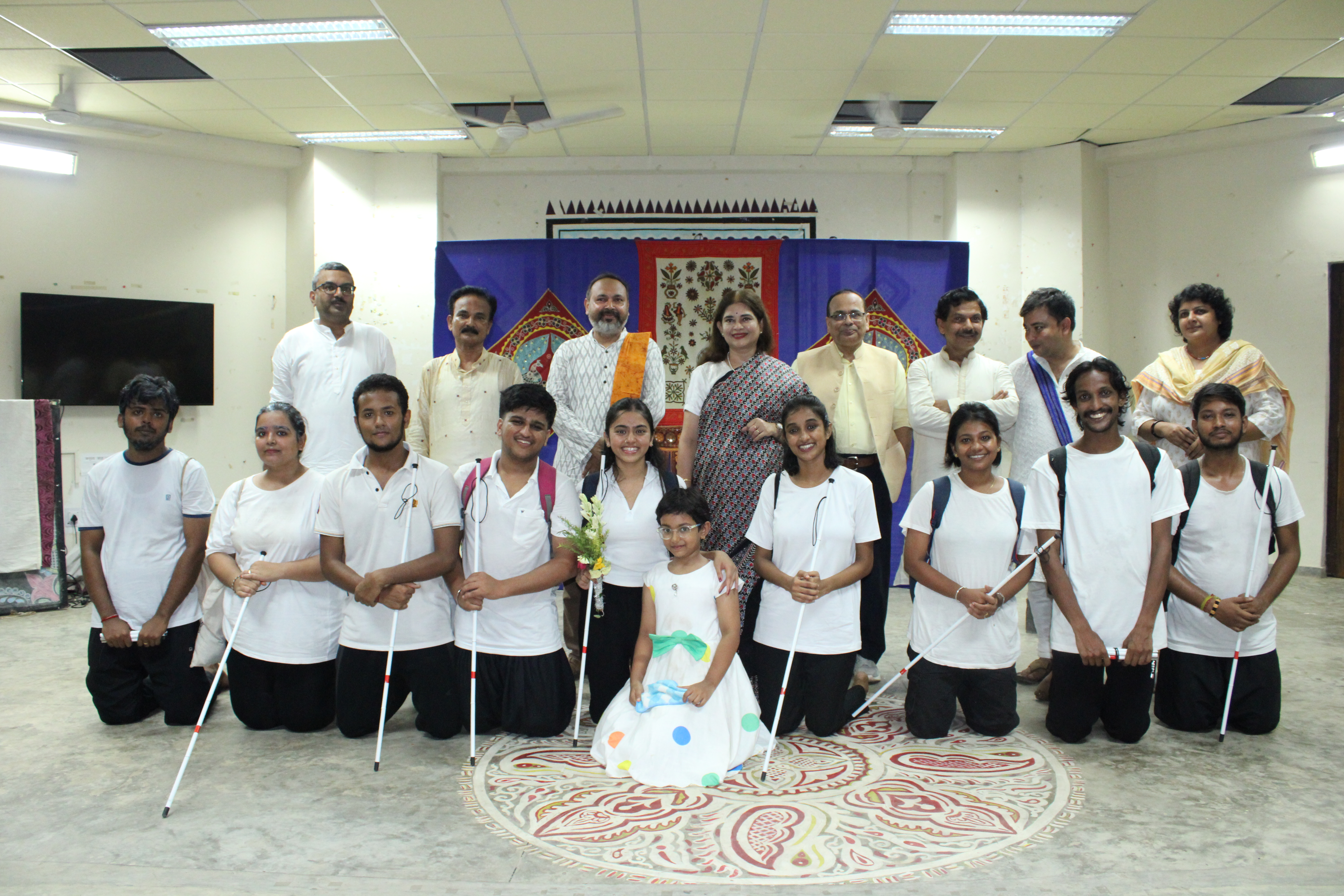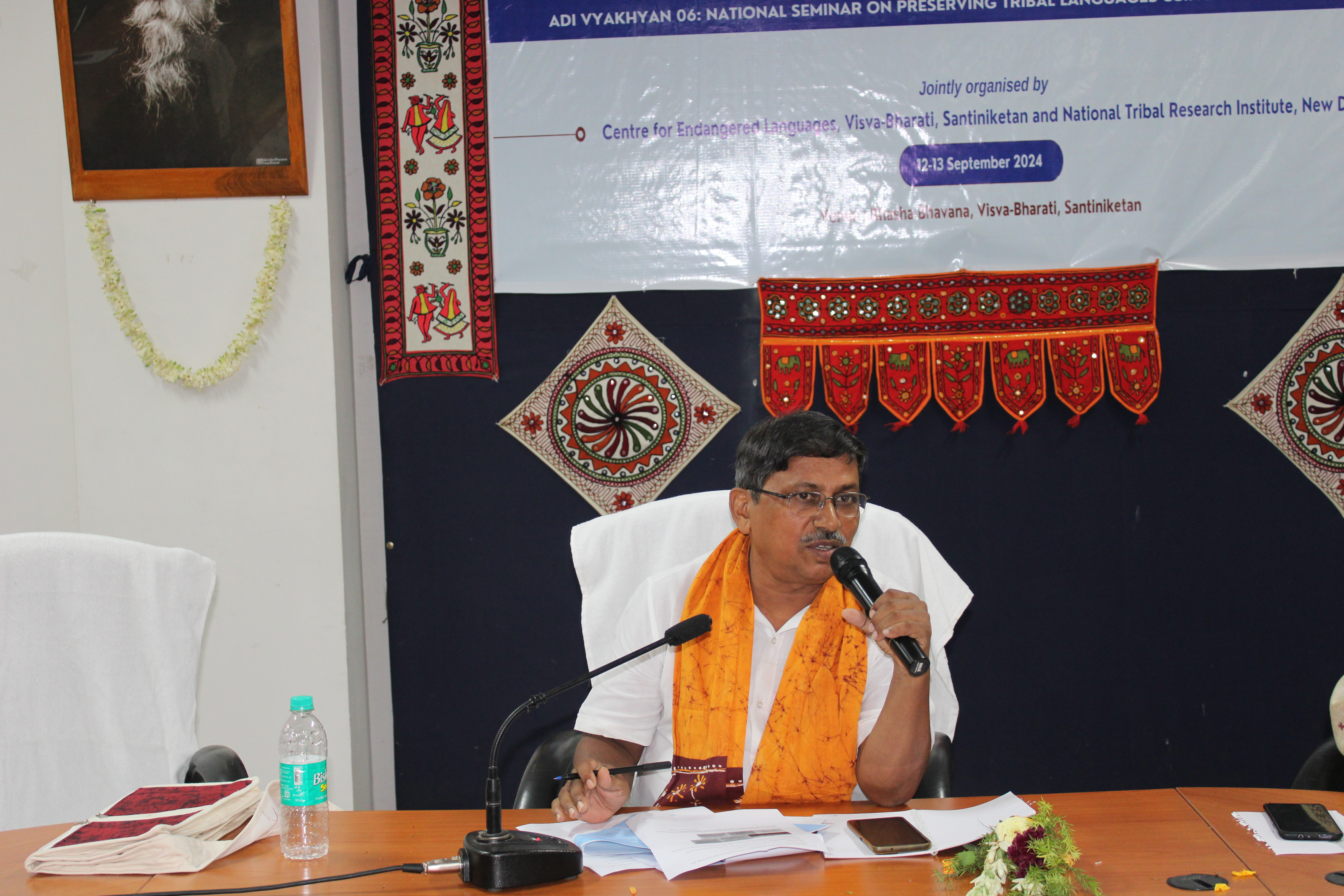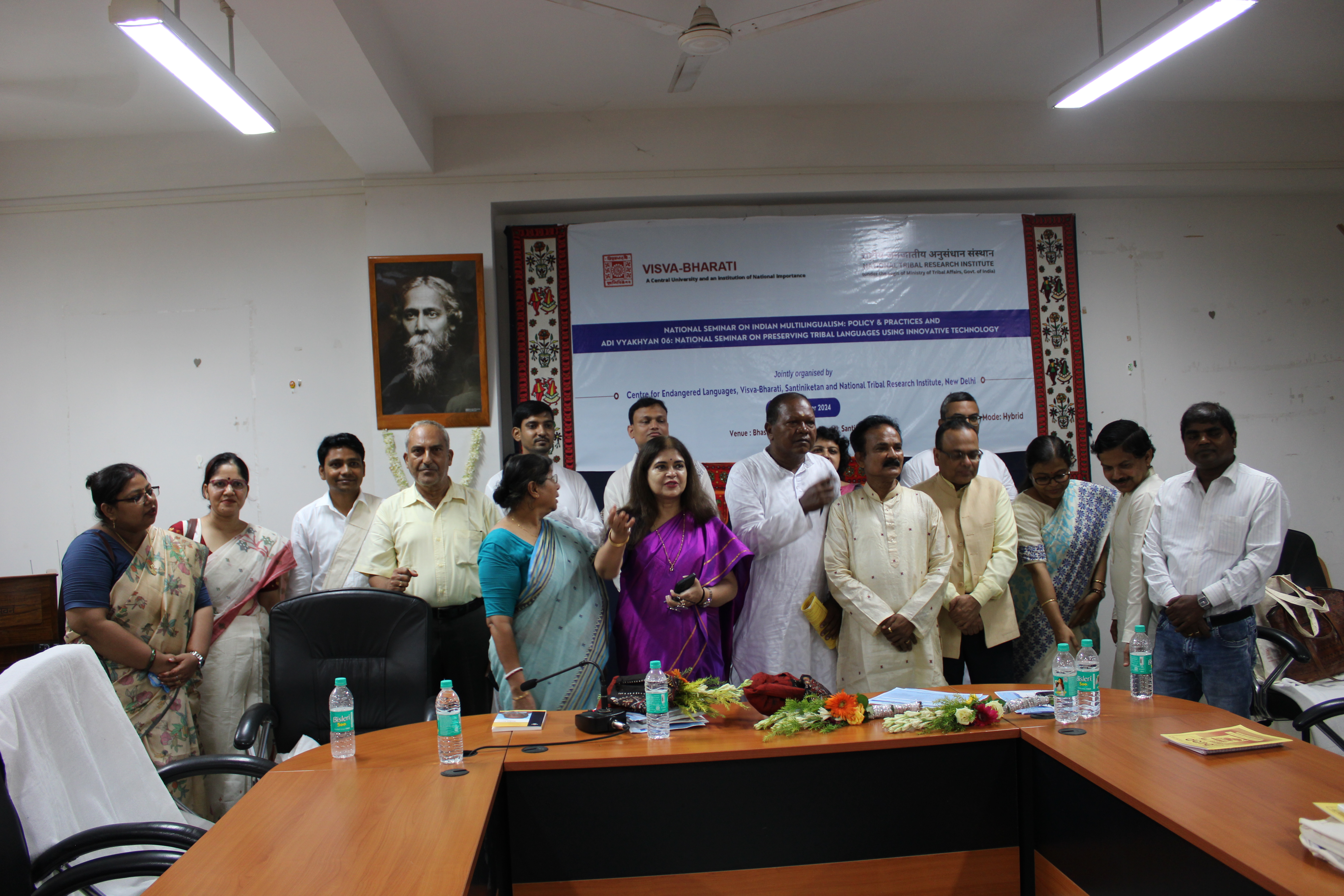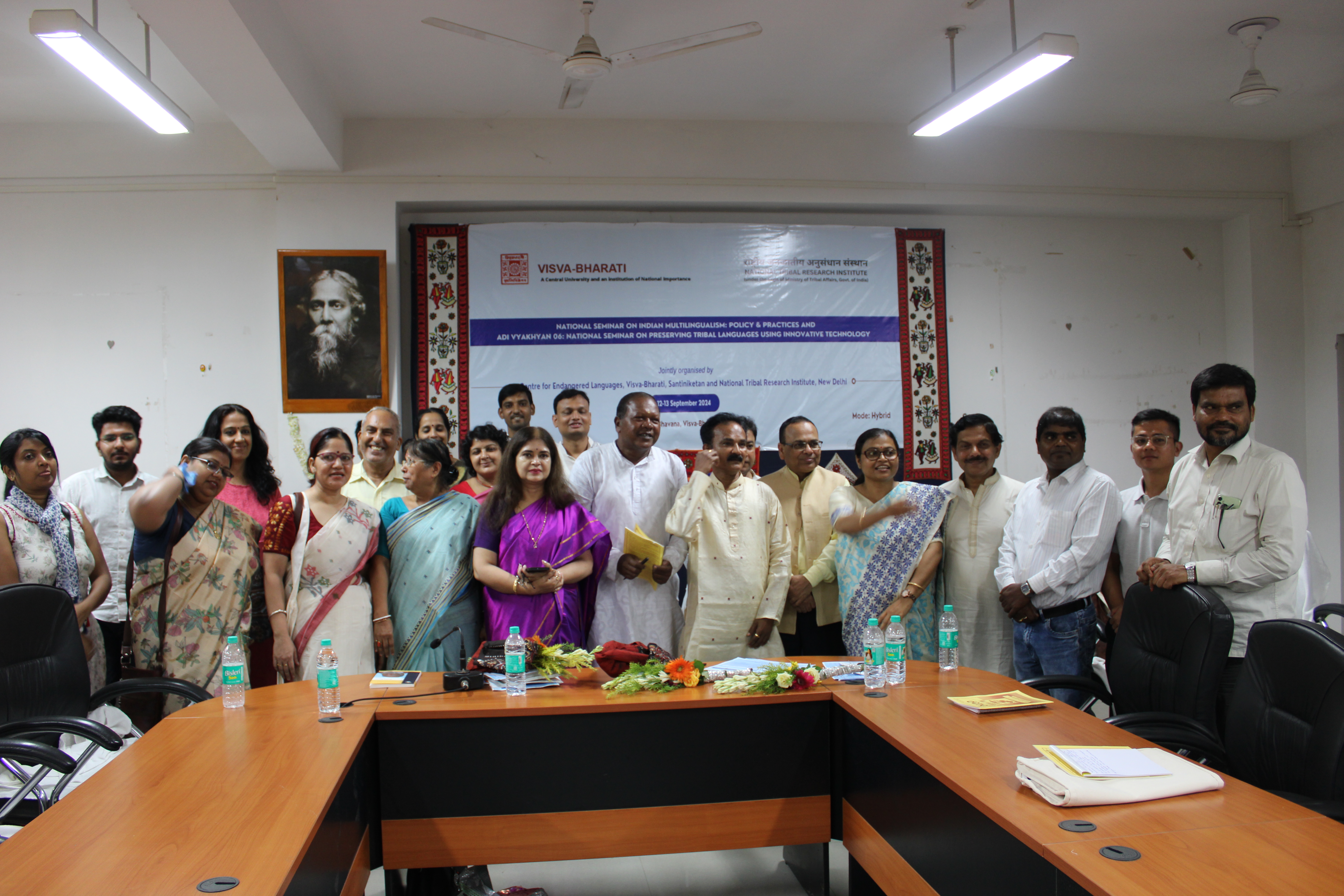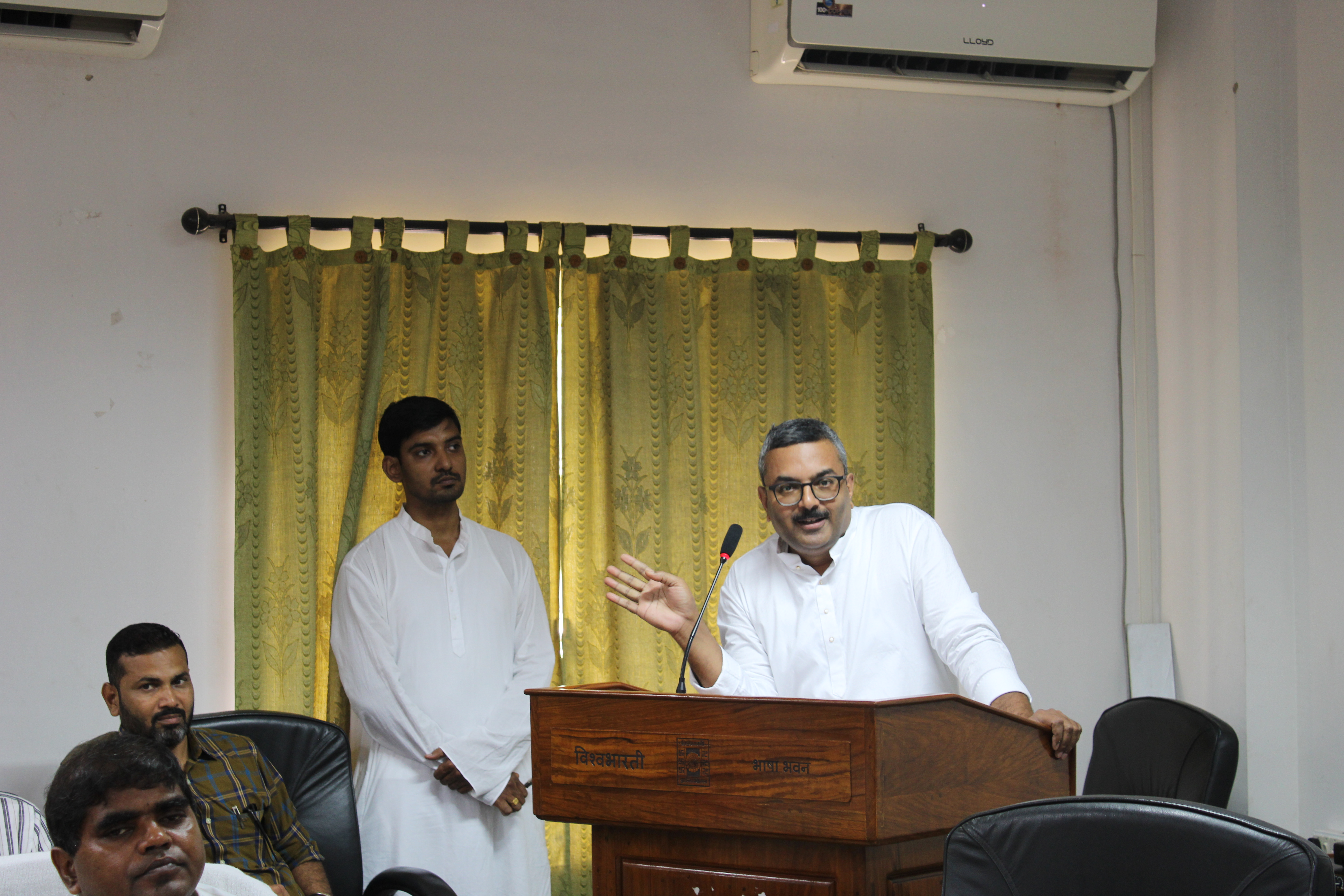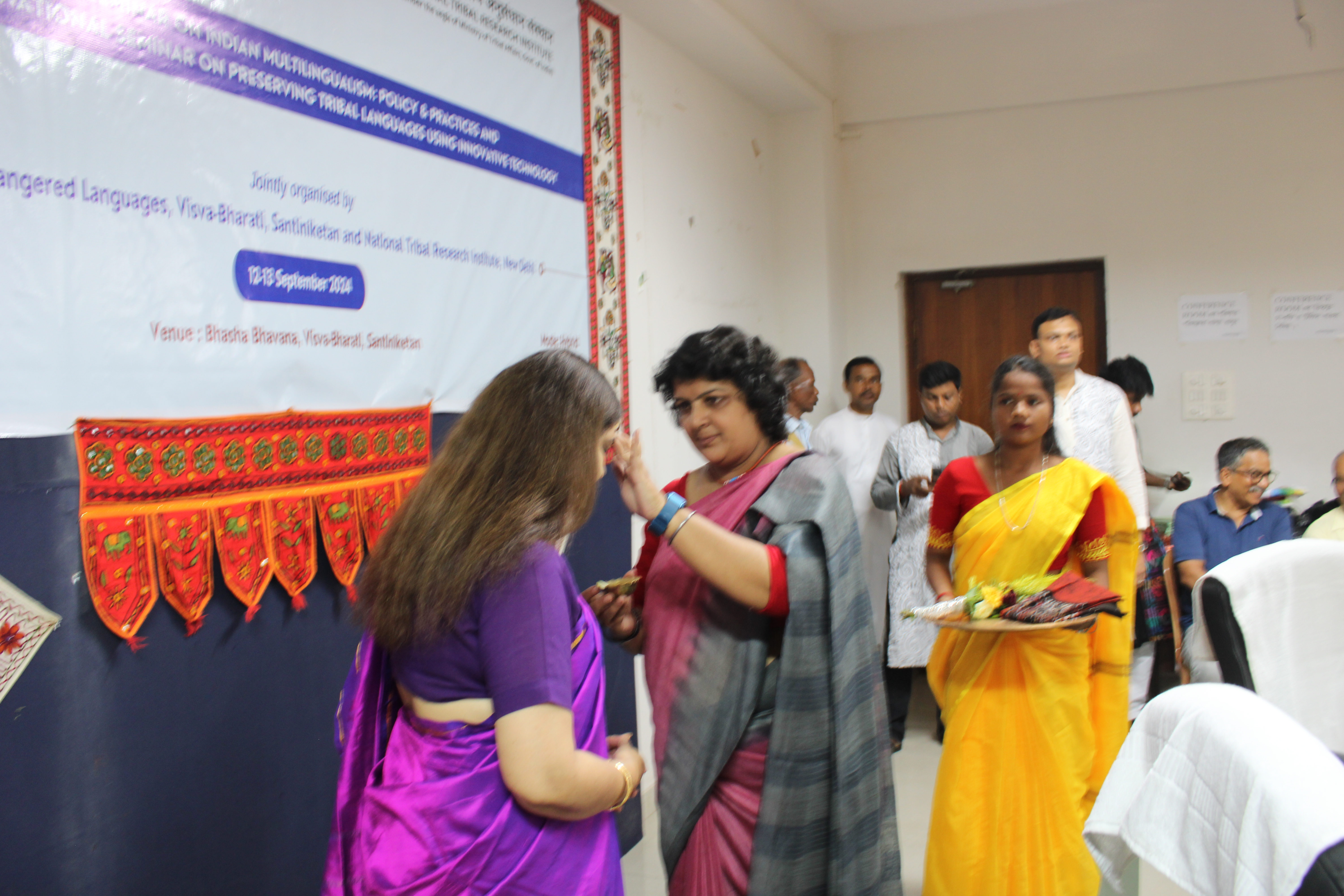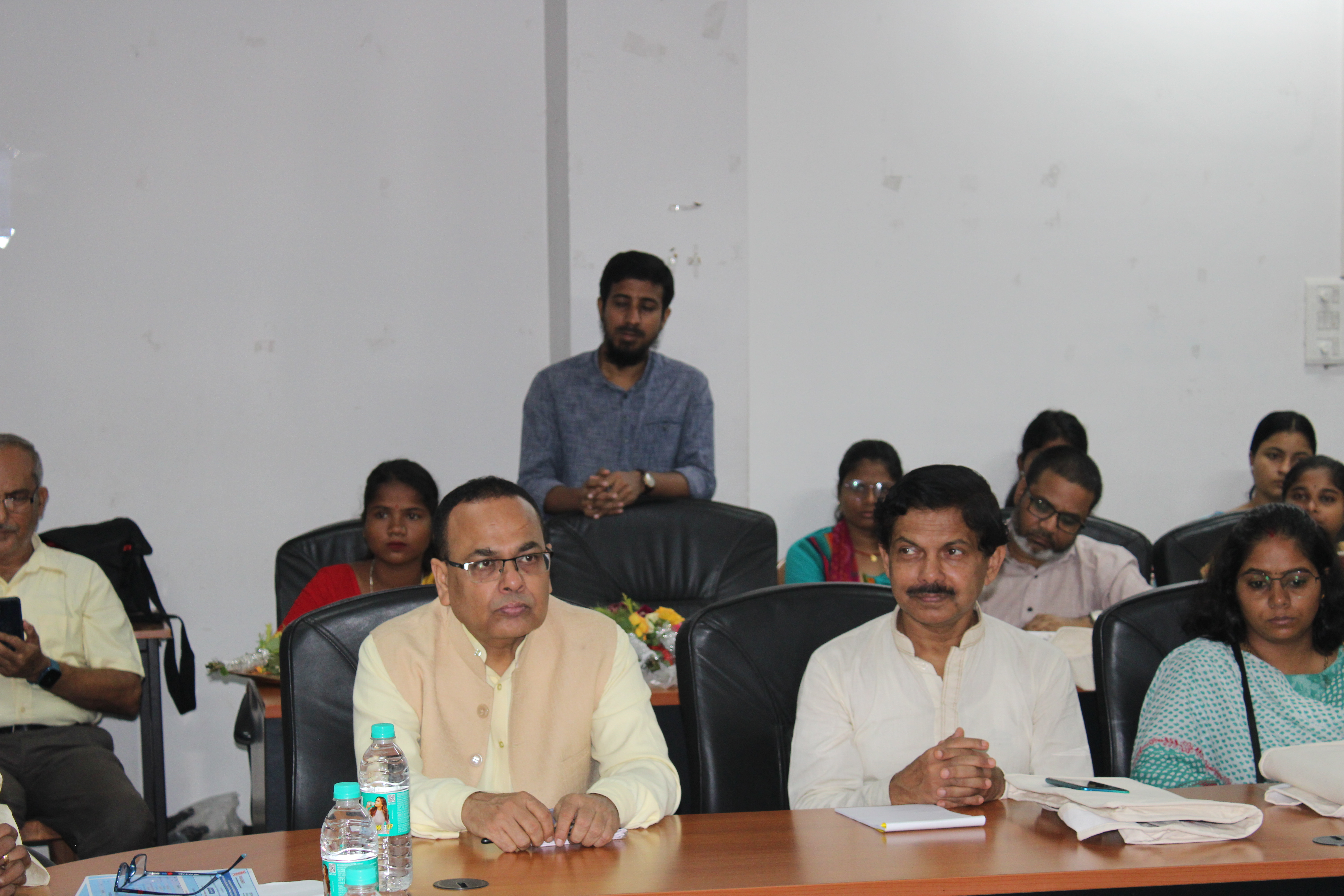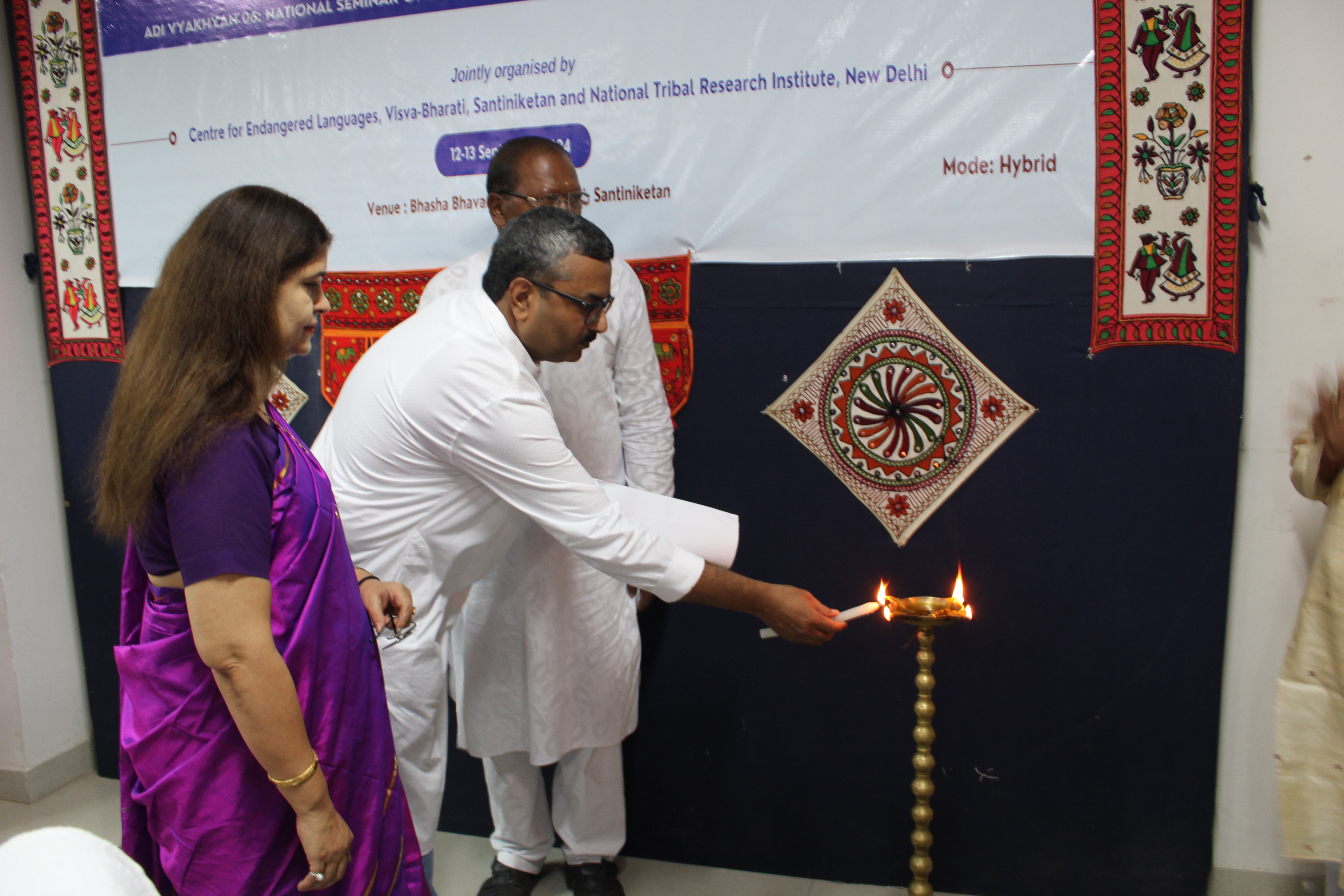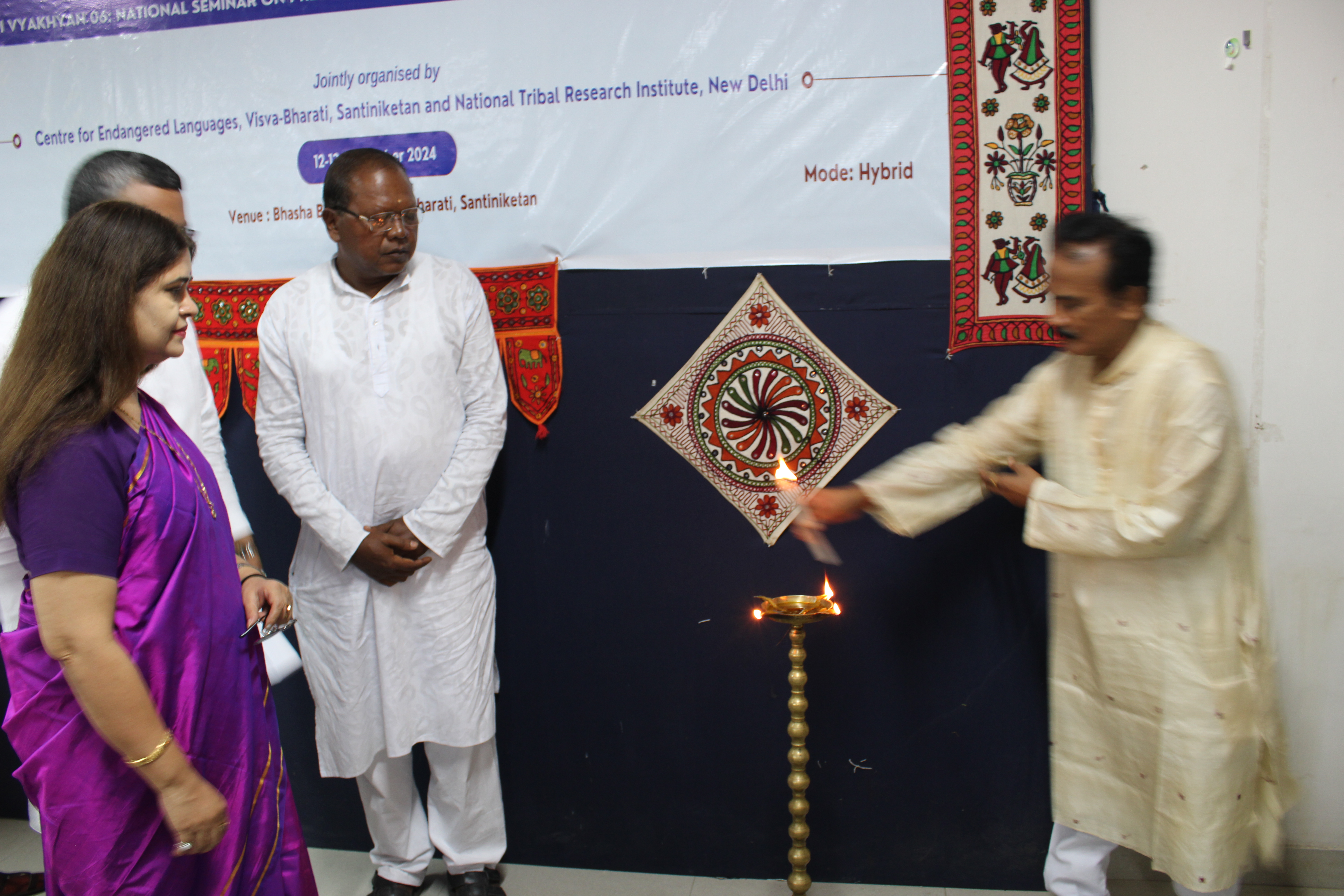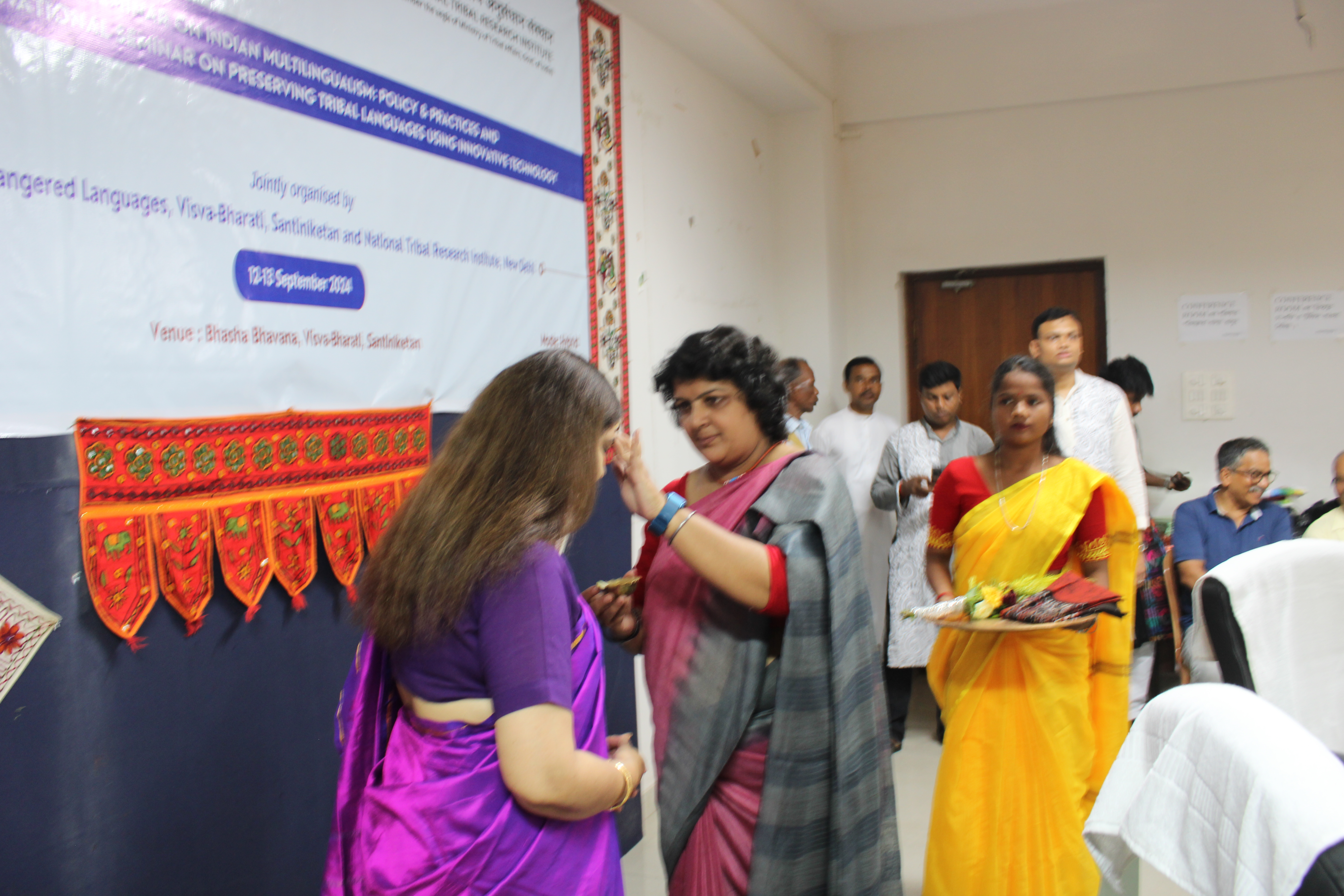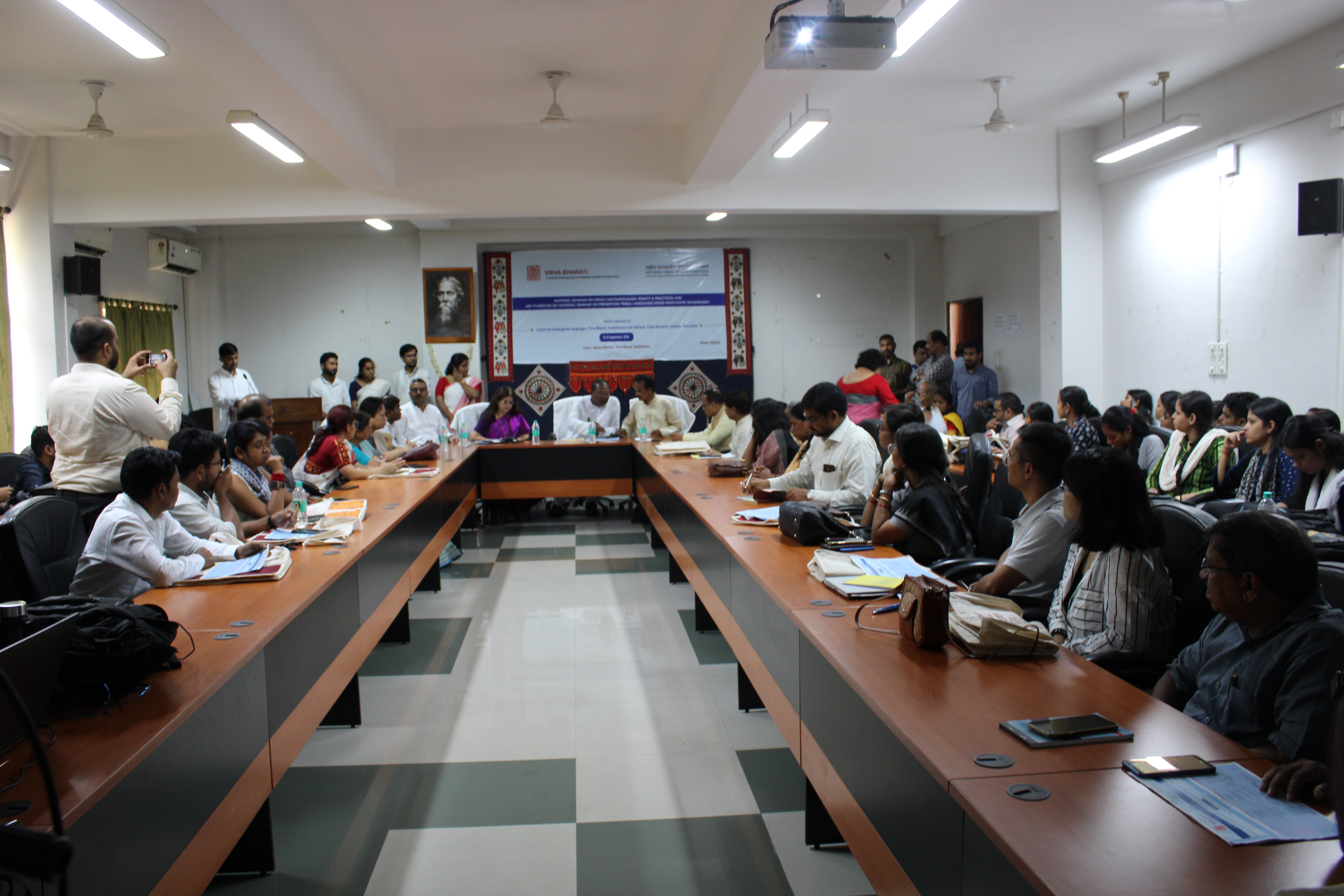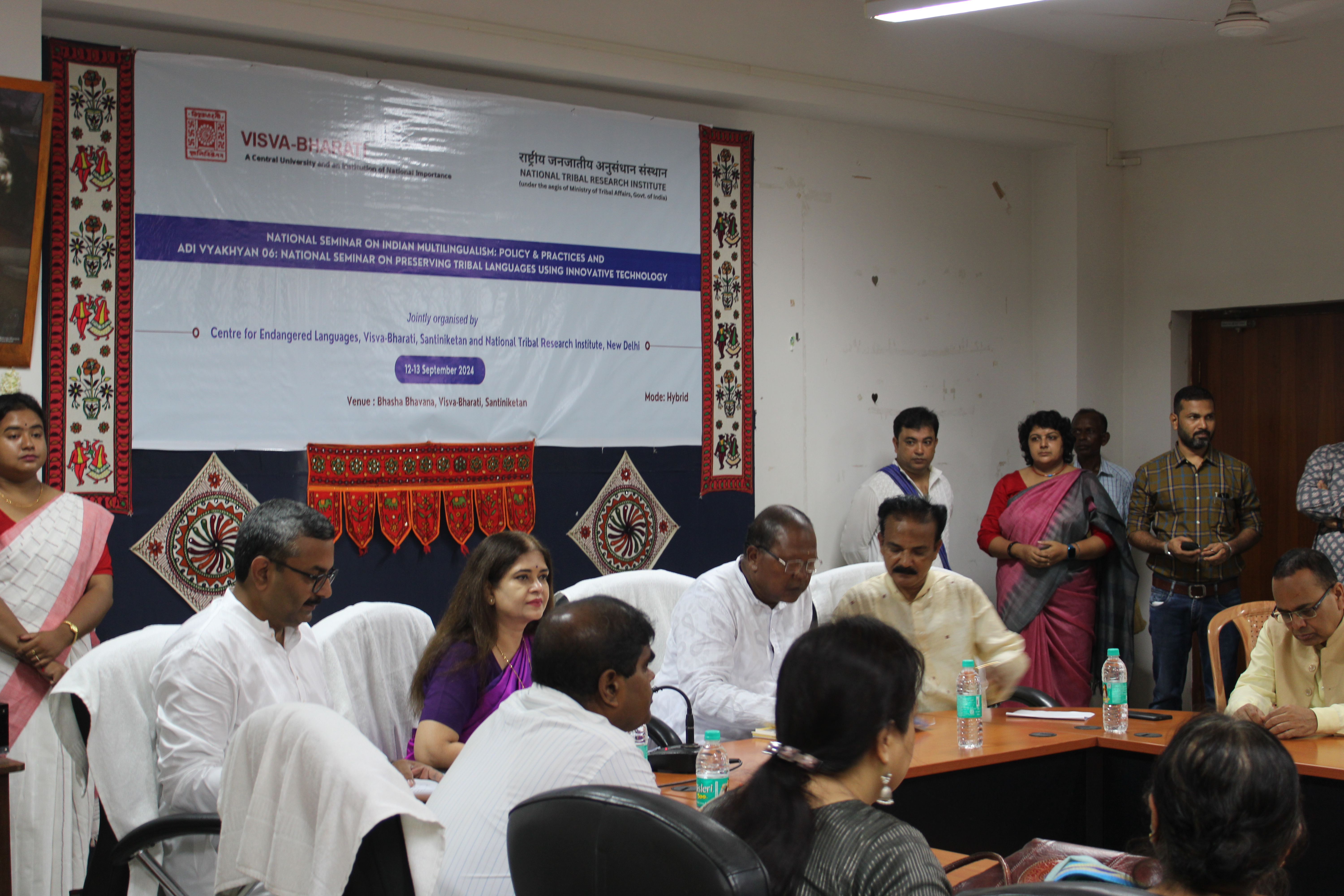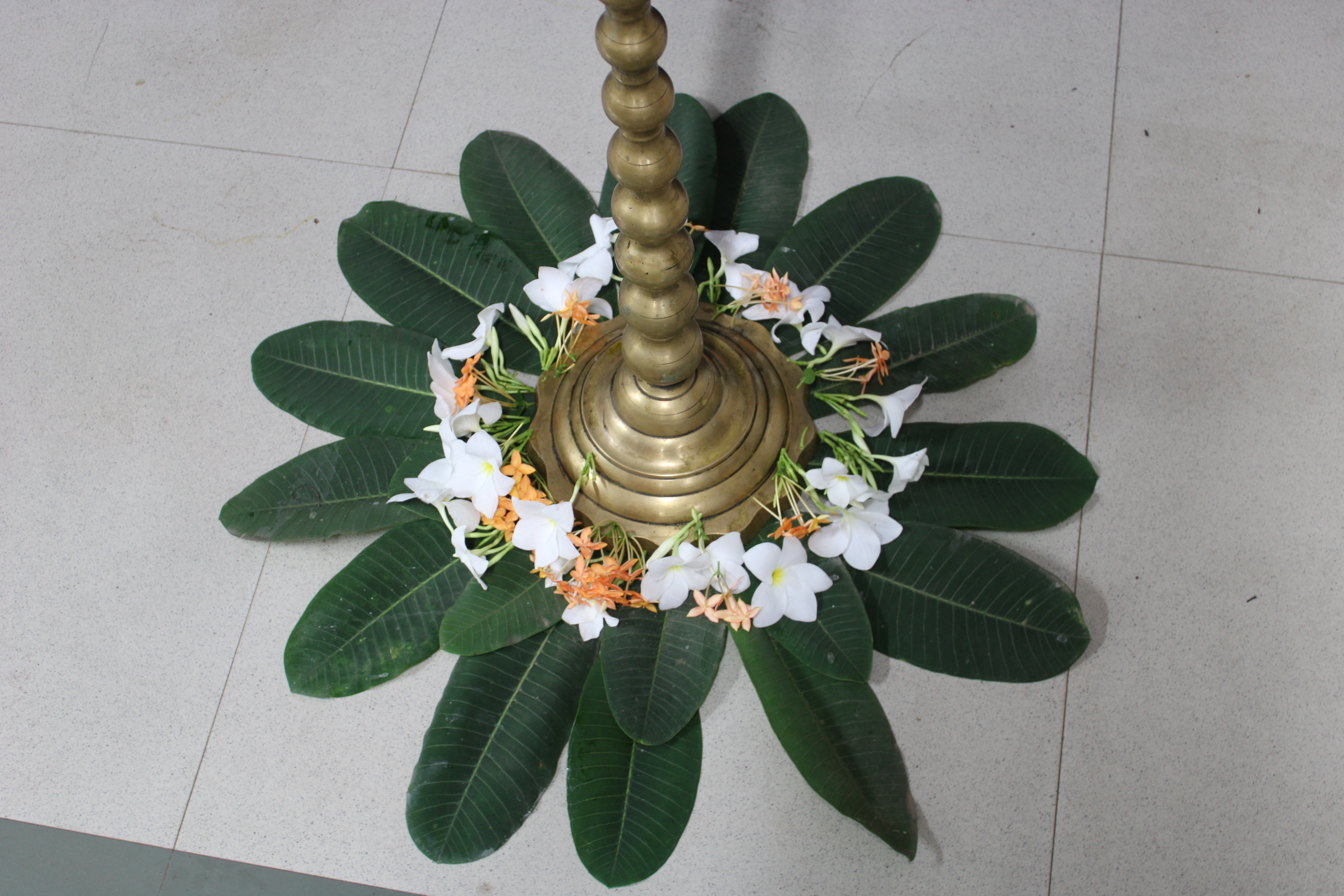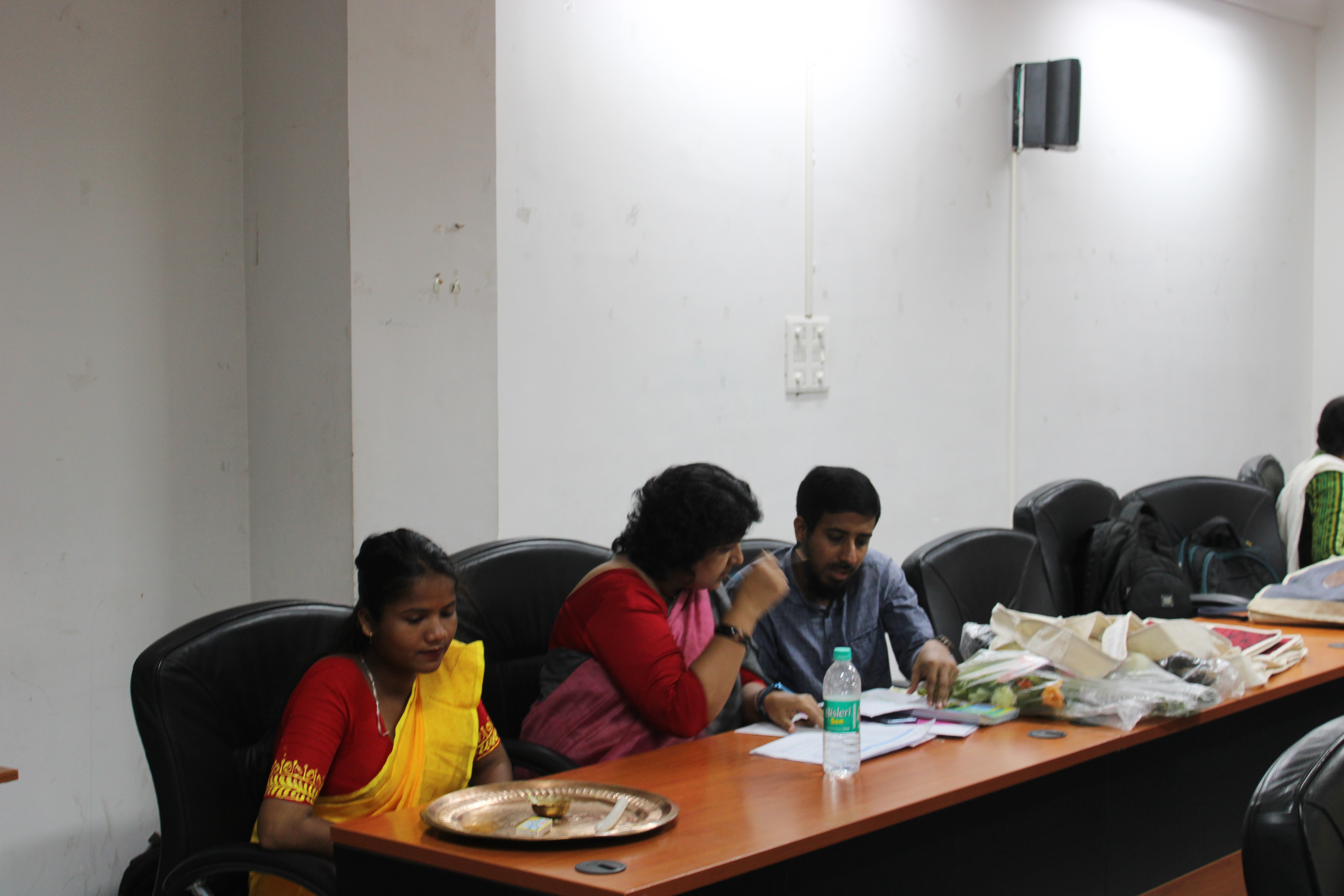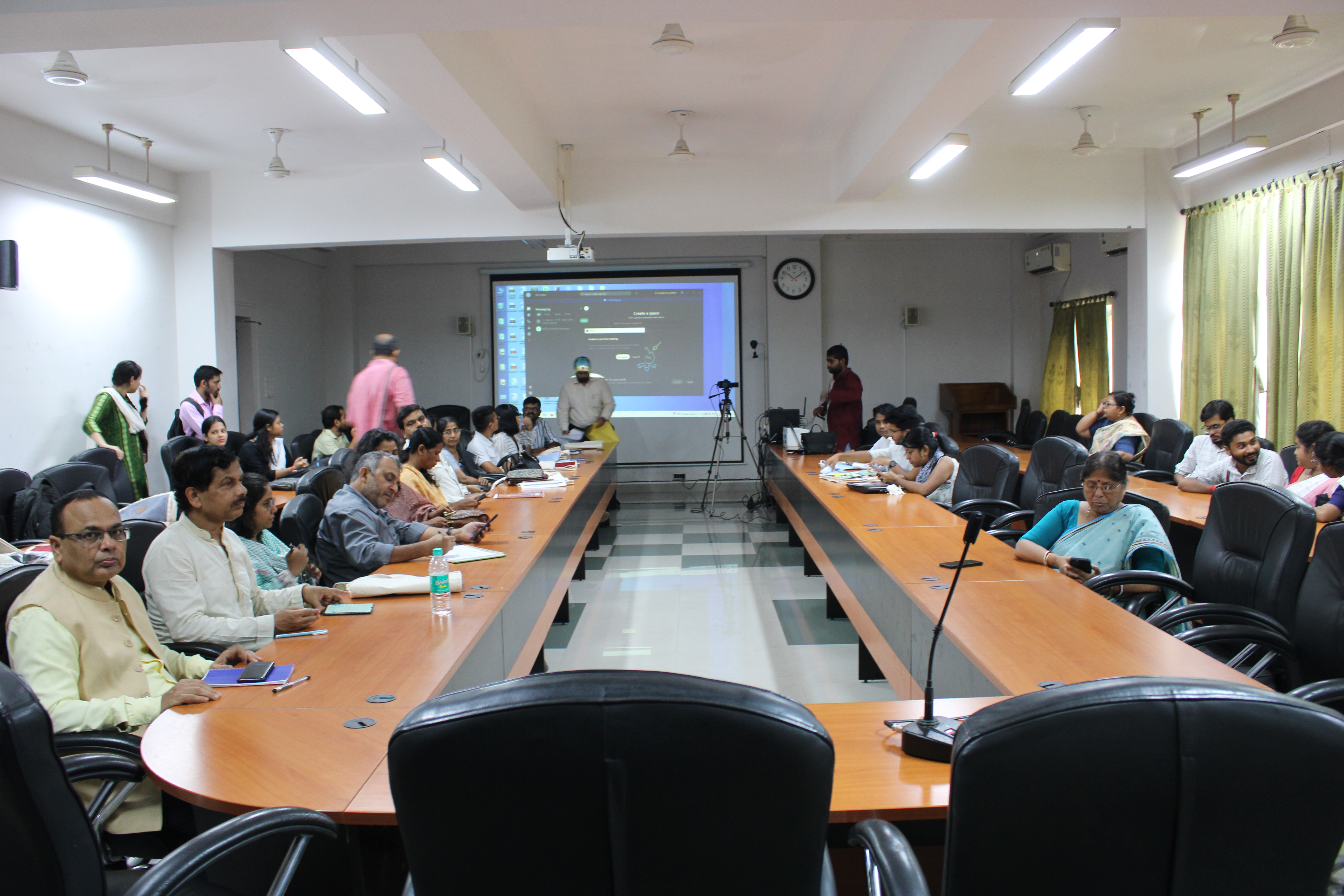Archive Event
-
National Seminar on Indian Multilingualism: Policy & Practices
National Seminar on Indian Multilingualism: Policy & Practices
National Seminar on Indian Multilingualism: Policy and Practices and Adi Vyakhyan 06: National Seminar on Preserving Tribal Languages Using Innovative Technology” jointly organised by Centre for Endangered Languages, Visva-Bharati and National Tribal Research Institute, New Delhi.
12-13 September 2024
The Honorable VC inaugurated the conference, Prof. Binoy Kumar Saren, Visva-Bharati, and the Dignitaries on the Dias, and a felicitation program was held. Then, a Udbodhoni Sangit was performed by the Students of Sangit Bhavana, Visva-Bharati. After that, Dignitaries on the Dias released two books, and a welcome note was delivered by Dr Arimardan Kumar Tripathi, Coordinator of the seminar, in which he shared the objectives of the event focusing on maintaining multilingualism in the country by using digital mediums, especially in the view of the digital India program. He also introduced and briefed about the web portal and Android application developed by CFEL, Visva-Bharati, where the language resources are available to the users based on the bibliographic data, including various multilingual dictionaries and language descriptions of endangered languages. An Introductory lecture on preserving tribal languages was delivered by Prof. Nupur Tiwary, Special Director, NTRI and Chair Prof. Dr. Ambedkar, Chair in Social Justice, IIPA. She talked about the activities of NTRI towards tribal communities throughout the country. Prof. Manoranjan Pradhan, Principal, Bhasha Bhavana and Chairperson, CFEL, Visva-Bharati, delivered the introductory note on initiatives for preserving endangered languages. He welcomed the delegates and introduced Visva-Bharati activities with special reference to endangered languages and research and development tasks conducted there. He added, “I am confident that the discussions from this seminar will provide valuable insights and inspire new ideas on promoting and supporting multilingualism in our communities, especially in the context of policies focused on NEP-2020 in the education system and society”. A presiding statement was delivered by Prof. Binoy Kumar Saren, Vice Chancellor, Visva-Bharati, Santiniketan. He said, ‘When a tribal language dies, valuable oral history, customs, and indigenous wisdom, often about the environment and sustainable living are lost. Language preservation also empowers tribal communities and encourages identity, pride, and continuity across generations, focusing on retaining multilingualism in the country”. Finally, Vinay Yadav, NTRI, Delhi, gave a vote of thanks.
After the tea break, the first academic session, titled Language, Culture and Ethnicity, started. Prof. Nupur Tiwary presided over the session. In this session, a total of 5 papers were presented. The first paper was- mavachi avan vahudi boli ke lokgeet by Gavit Rakesh Raju. He talked about Mavachi's location and population. He mentioned different types of songs, such as songs of marriage, lullabies, and songs in death rituals and also mentioned a few musical instruments. Then, he sang a song from the Mavachi language. He also noted the role of women through a song. Then he talked about a lullaby and sang two songs. Then he spoke of a kuldevi (demogra) and its significance and sang songs. Then, he spoke of songs related to the death ritual. Another area where he talks about rodari is a dance drama. Lastly, he concluded with all the songs, highlighting the song's essence. The next paper, titled ‘Koyaturonn ki bhasha ka sanrakshan jaruri hai’ by Dr Janardan, started with the term Koytur language and its evaluation. He mentioned the Gond and Gunja Bheel language and their cultural significance. The historical tradition of Gunja Bhil will be saved by saving language; however, the history of Gondi is available in Sanskrit and Persian. Gondi is not a lost language because of its speakers and grammar books. It is also considered in Dravidian languages. Gondi's history is also available in written texts. Gondi is a resourceful language, but it needs to get academic status. The next paper was ‘On Tamu and Tamu Kyi: Culture and Identity by Rishita Thapa. She nicely talked about the culture and identity of one of the major ethnic tribes of Nepal, Tamu, more commonly known as the Gurung, and why the language is endangered. General overview of the language, its culture, and rituals. She talked about different types of songs, folktales, and problems that were created after Nepali became an 8th-scheduled national language. She also mentioned that being a Nepali is a geopolitical aspect, but in a broader sense, it is an ethnic identity. Promotion of awareness of own culture and identity. Vital information about the Tamu tribe and their status. Then Ronald Kharsohtum presented a paper titled ‘Challenging Sonority in Khasi: An Analysis of Phonotactics through Beats & Binding Theory. He started with what sonority is and its characteristics, using different examples. Then, he showed the optimal sonority distance principles and explained beats and binding theory. The main idea of the theory is that neighbouring sounds should differ from other sounds. He also mentioned the Net Auditory Distance with examples. Then, he showed how to calculate NAD by using articulation. The presence of clusters in the onset position. These clusters do not necessarily follow the Sonority Sequencing Principle. Apart from true clusters, the language also has sesquisyllables. Described sesquisyllables along with examples. He mentioned Baroni’s classification of sonority by using the scale, which explains this phenomenon by giving importance to articulation apart from the sonority hierarchy principle. The next paper was on An Anthropo-Linguistic Study on Clan Formation of Toto of Totopara in West Bengal by Dr. Arup Majumdar. He started by describing Linguistic Anthropology. He talked about clans among Toto and a few morphological properties of the lexical items related to clans. He also described what a clan is. The domain from where (fauna semantic domain) clan names are derived. Borrowing of clan names from different languages such as Birhor. He talks about different clans' names. Finally, Prof. Nupur Tiwary delivered a presiding statement, and Dr Prafulla Meshram gave a vote of thanks.
After the lunch break, the second academic session started, and the theme of the session was Mother Tongue Education and Policies. Prof. K. C. Sahoo presided over this session. A total of 8 papers were presented in this session. The first paper, titled Difficulties Faced by Students in the Higher Education Due to Medium of Instruction and Examination, was presented by Mr Ghanashyam Khatua and Dr Sharmila Yadav. They studied the difficulties faced by Students in higher education due to the medium of instruction and examination. One of the presenters mentioned how he faced problems in higher education. They talked about the importance of NEP 2020 for mother tongue education. They said most of the students faced a language gap in higher education. The next paper, titled ‘National Education Policy-2020 and Language Education at School Level in India’, by Dr Prosenjit Saha, discussed different policies on Mother tongue education after independence. He mentioned that multilingualism is an asset for our nation. He also mentioned the role of language in mixing cultures and different strategies for teaching English. In the next paper, titled ‘STREAM Approach for Integrating Tribal Languages in School Education’, Dr Mohini Tripathi discussed how the STREAM approach would be helpful in integrating tribal languages in school education. In the next paper, titled ‘Cultural Pedagogy in Removing Learning Poverty: An Initiatives Towards Multilingual Education, ' Dr Soumi Mandal discusses how culture is an important factor in language development. She also mentioned how many schools have been closed after COVID. In the next paper, titled ‘The Significance and Challenges of Indigenous Lexical: Language, Culture and Identity Preservation’, Akash Bhagat and Arimardan Kumar Tripathi discussed the lexical documentation of the Birhor language. They mentioned some concepts that cannot be translated into other languages due to cultural gaps. The paper titled ‘The New Education Policy of 2020 and Kokborok Language: A Sino-Tibetan Language of Tripura, by Dr Thingnam Anne presented the study on the Kokborok language of Tripura. She mentioned documentation is one of the most important language preservation processes. In the next paper titled ‘A Case Study of Language Attitude and Shift among the Mavilan Tribes of Kasaragod’, Anupama T. discusses how Mavilian tribes always shift their language from Malayalam to Tamil. In the next paper titled ‘NEP’s Focus on Regional Language: Politics of Protection, Preservation and Promotion of Mishing Language of Assam in an Era of Globalisation, Dr Marie Pegu discussed the controversy between regional language vs minority languages and how minority languages are shifting towards other regional languages like Assamese, Hindi or English. Finally, Prof. K. C. Sahoo delivered a presiding statement, and Mahbub Zahedi gave a vote of thanks. After finishing the session, there was a tea break followed by a cultural program, which was the final academic programme of day one. Some cultural programmes were performed, out of which the dance program was coordinated by Sharmishtha Mukhopadhyay and a play titled Blind Opera was directed by Dr. Mritunjay Prabhakar.
The third academic session was started on the 2nd day, which is 13th September 2024. The theme of this session was Language, Nation and States. Prof. Shailendra Kumar Singh presided over this session. A total number of 8 papers were presented in this session. To begin with, Anurag Mittal presented ‘Assessing the Vitality of Brajbhasha and Its Neighbouring Languages in Uttar Pradesh: A Comparative Analysis’. The presenter introduces Brajbhasa, its origin and its focused region in Uttar Pradesh. Its proximity to Kannauji Bundeli, with a map for reference. The presenter highlights the significant cultural value of these languages and their present status. The presenter mentions the Braj region, where Brajbhasa is spoken and its ties to Vaishnavism. The importance of Brajbhasa is rooted in rich cultural and devotional traditions. Its status was once a major literary language in the mediaeval past. The presenter mentions the rich historical and cultural importance of Bundeli and Kannauji and their focus areas. The author further mentions the need for “Language Vitality”. It introduces the EGIDS framework in detail for the study of these three languages, which assesses “intergenerational disruption” and subsequent change in these languages. The presenter also showcases a detailed report of his findings through the EGIDS framework for these three languages. In the next paper titled ‘Rethinking Language Debate After Independence by Dr Indranil Chattopadhyay and Dr Sukanya Sarkar Sasmal, The presenters take us back in time to the debate of a national language for a then newly independent, secular India and the proposal for Hindi to receive that status during the penning of the Indian constitution. The presenters discuss the necessity of English as a Lingua-Franca and the argument for using Hindi as the national language. Then, with the title ‘Transformation in Policy and Practices in Multilingual Jharkhand, ’ Dr. Binay Pattanayak gave a brief overview of the multilingual landscape of the state of Jharkhand. And the status of the languages in the contexts of official business, education, etc. The presenter introduces the Research cell M-TALL Akhra, a setting for research and innovations in mother tongue education and child education. M-TALL Akhra undertook various sociolinguistic surveys to understand the state of child education in 24 districts and the financial and social status of inhabitants in these areas. The presenter discusses the 33 indigenous communities and the extent of their contact with other major languages in the state of Jharkhand and provides relevant statistical and cartographic data. The presenter discusses the difficulties children face at school due to the medium of instruction not being available in their mother tongue. And potential ways to tackle these challenges and the required policies that must be implemented. The presenter also showcases various textbooks developed in 16 languages and five scripts. Then, the paper ‘Multilingualism & Multiculturalism: Policy, Praxis and Prosperity through Cultural Traditions of India’ was presented by Dr. Mrityunjay Kumar Prabhakar. The presenter talks about the need for cultural policies, cultural “soft power”, and “cultural dominance”. And it’s a glaring example during COVID. The presenter talks about the transformation of the markets to appease and conform to dominant cultures. How does Western culture dominate various Indian cultures through the media? How is Western culture subtly manipulating the minds of Indians through the positive portrayal and soft imposition of their culture through the movie industry and social media? The presenter talks about how capitalism alone motivates cultural practices now. The presenter argues in favour of cultural policies due to the vibrant multicultural landscape of India and the need to continue the diverse cultural practices in every corner of India. The presenter argues that Western countries are slowly using their soft cultural power to diminish this multicultural vibrancy in India. The presenter mentions the numbers advantage enjoyed by the Indian diaspora worldwide and ways to export, promote and proliferate Indian values, practices, and culture worldwide wherever the Indian diaspora exists in sizable numbers. Then, ‘bhashai asmita avan loktantra’ was presented by Anima. The presenter discusses language, identity, democracy, and how language empowers democracy, but it is also a hurdle. Not all languages are equally developed and proliferated; many are looked down upon. However, to create a healthy democratic society, such backward thoughts must be discarded. Language is not a mere medium of communication; for a person, his mother tongue is his identity, culture and history. The presenter talks about various literary works on this topic of multiculturalism and the hurdles of communication between people who do not share a common language or have any common cultural practices. The presenter mentions that no matter how far a migrant worker from India may go for work, they endeavour in earnest to preserve their language, identity and cultural history. No matter how far from their homes a person is displaced, he feels that longing for his comfort zone back home, entwined with his culture and identity. The next paper, titled ‘Mother Tongues in the Linguistic Diversity of Odisha: Unintended Consequence and Echoes of Survival was presented by Dr. Biswanandan Dash. The presenter talks about Odisha as a treasure trove of languages and the concept of Mother tongue. The notion of a mother tongue is rooted in myth and ideology. The presenter argues that it is impossible to define what ‘mother tongue’ actually is in two or three words. The presenter highlights that Odisha has 62 indigenous communities, speaking 29 languages, many of which are in decline and endangered. And historical influences of languages through literary work. The presenter mentions the presence of major language families in Odisha and the erosion of minority languages. No protection for minorities exists in the state in the age of the modern education system. The modern education has colonial roots and marginalises indigenous languages. The presenter specifies the urgent need for government intervention in the form of language documentation and mother tongue education to ensure the survival of these indigenous languages. Then, ‘Safeguarding Chakma: Strategies for Language Revitalization and Preservation in Tripura’ by Papiya Chakma was presented. The presenter introduces the indigenous Chakma community that is native to the Chittagong Hill tracts of Bangladesh and in the Northeastern states of India. The presenter discusses the major groups of Chakma and a few other minor groups. The presenter highlights the importance of preserving the Chakma language and its revitalization efforts owing to its rich cultural heritage. The presenter talks about employing a diachronic socio-cultural approach to analysis in this endeavour. The presenter notes ongoing efforts by the Tripura government in the form of official recognition of Chakma. The implementation of special schemes and the uplifting of the Chakma people in Tripura were submitted to the Ministry of Tribal Affairs. The presenter highlights effective revitalization strategies for Chakma. Then, Amitava Banik presented a paper on ‘Rabindranath Tagore's views on the role of languages in social progress and cross-cultural interaction. ' The presenter highlights Tagore’s views on the mother tongue and the need for the study of science and mathematics in one’s own mother language. The presenter also mentions Tagore’s various efforts in promoting language, such as creating China Bhavan in Visva-Bharati. The presenter also mentions the challenges of education in childhood and the hurdles of learning a foreign language with an immature mind. The presenter also discusses the politicization of education and its evolution into a product from a factory. The presenter argues that the foreign education models that were adopted in India only exist to shackle Indians and inhibit us from fully expressing ourselves. The presenter mentioned the various trips Tagore had taken to understand Chinese culture and education better and foresaw an eventual collaboration between India and China in cultural studies and education. The presenter mentions the politics behind Hindi being propped up as a national language when a large number of Indians do not speak Hindi in a reasonable capacity. Finally, Prof. Shailendra Kumar Singh delivered a presiding statement, and Dr. Mrityunjay Kumar Prabhakar gave a vote of thanks.
After the tea break, the fourth academic session was started, and the theme of the seminar was Language Preservation and the Use of Technology. Dr. S. N. Ojha presided over the session. A total number of 5 papers were presented in this session. To begin with, a paper titled ‘Oral Tradition of Mahali: Exploring their Significance in the Preservation of Language by Sahinur Sardar & Arimardan Kumar Tripathi was presented. The presenters discuss the Mahali community, their roots in Santhali and similar cultural practices. The presenter discusses the Mahali origin, heritage occupation, and their overall status in the tribal community. The presenters introduce the two Mahali villages that were used for sample data and the analysis of oral tradition, folklore, songs, riddles and general practices. The presenters then detail the marriage practices in Mahali and its entanglement with casteism. The presenters talk about the beautiful Mahali folk songs and their history and significance in the community. The presenters then showcase some riddles and proverbs that have been popularly practised in the community for generations. The presenters conclude with a remark on how modern cultures and technology are slowly erasing Mahali culture and traditions. Then, a paper titled ‘gondi bhasha ke sanrakshan ke liye digital interapses (balaghat jile ke vishesh sandarbh men) by Tufan Singh Pardhi, Pankaj Kumar Tembhare and Dr Harshalata Petkar was presented. The presenters introduce Gondi with special reference to the Balaghat district. The language family of Gondi and its distribution area is scattered through multiple Indian states. The presenters mentioned the number of speakers in Balaghat and other languages that influence the region, with statistical information for reference. The presenters mention efforts in developing a writing script for Gondi and the motivations behind the need for standardization. The presenter outlined the need for the preservation of Gondi through innovative digital technologies. It also lists technologies such as artificial intelligence systems that can be utilized in this effort. Then, a paper titled “Preserving Cultural Heritage: Community Engagement in Language Preservation at the Foot of Malyagiri Mountain Ranges among Tribes’ by Amrit Barla was presented. The presenter discussed the importance of language preservation at the foothills of the beautiful Malyagiri Mountain range. The rich cultural traditions in the area are intertwined with the area’s biodiversity and flora. The presenter highlights the importance of storytelling for the propagation of culture from generation to generation. The presenter introduced the Barkote block as the field of observation where 200 households in 9 villages were surveyed. The presenter describes the overall methodology for these surveys and the qualitative methods of analysis. The presenter details Oral traditions, Rituals, Ceremonies and the scope of regular community interactions. The presenter also mentions the importance of traditional knowledge, which is paramount to preserve cultural practices. In the next paper titled ‘Artificial Intelligence and Linguistic Democracy Traditionalist Approach of Language Use in the Pedagogical Development & Change by Partha Sarathi Sarkar, the presenter highlights how AI can potentially improve education in the age of globalization. The presenter notes that current mass access machine translation services cannot translate minor languages. The presenter envisions AI taking up this task of aiding in translating these marginalized languages to elevate their status and to utilize them for mother tongue education. The presenter notes that every person has the equal right to live equally in this world. Then, Prof. Inderjeet Singh Sodhi and others presented a paper titled ‘Technology for Preservation of Tribal Languages in Rajasthan--Issues and Prospects. ' The presenters discuss the application of technology in the preservation of tribal languages in Rajasthan. The presenter notes the concept of tribe and details the various tribes of Rajasthan and statistical data on total population and caste. The presenter highlighted the various challenges with concern to language in tribal communities in Rajasthan and described a cartographic survey by RSCERT. The RSCERT has also developed dictionaries and primers for nine districts. The presenter notes that Tribal children face a major hurdle in school in terms of language barriers. A digital library for tribal communities was developed, and books were delivered to the children in these communities. Finally, Dr. S. N. Ojha delivered a presiding statement, and Dr Binay Pattanayak gave a vote of thanks.
After the lunch break, the fifth and final academic session of the seminar was started, and the theme of the session was Multilingualism and Language Interface. Dr. Tapu Biswas presided over this session. A total number of 5 papers was presented in this session. A paper titled ‘Teaching English in a Multilingual Setting: A Case for Translanguaging by Dr. Srividya S. was presented. The presenter spoke about the future of English in a rural setting. Elaborating on the challenges of surviving in a multilingual environment with respect to education. The presenter described a socio-economic study on school students and their dropout rate. The gov. primary school in Kozhinjampara in Pallakad was chosen as the study area. Translanguaging is emerging naturally as a convenient methodology. The students showed surprising aptitude in translating their own mother tongue in writing practices. The presenter explains the challenges and advantages of a multilingual classroom. The study enhanced the linguistic resources available to each student. The presenter clearly outlines multiple recommendations for translanguaging practices. Then, ‘A Comparative Study between English and Bangla: The Perspective of Phonemics and Morphology by Silpi Gayen and Arup Majumdar was presented. The presenters started with a basic lesson in Linguistics on notions of Phonetics and Phonology. Followed by a short description of cardinal vowels in Bangla and English. The presenter followed up with discussions of vowel length, reduced vowels, semi-vowels, etc. The presenter talked about each consonant in both Bangla and English and their similarities and differences. The presenter then talked about general morphology, syntax and semantics in Bangla and English. Then, ‘The Interface between Mahali and Bangla in tribal society by Arka Das and Arimardan Kumar Tripathi was presented. The presenters introduced the intricacies of the Mahali language, its roots in North Mundari, and where it stands with respect to its relationship with Bangla in West Bengal and Hindi in Jharkhand. The presenters noted the phonological tendencies of the Mahali speakers in West Bengal and in Jharkhand. The presenters noted common loan words from Bangla to Mahali and phonological variations in many of these loan words that have been altered since their adoption into Mahali. The presenters highlighted the language attitude of the Mahali people towards dominant languages and their endeavour to enter “high society” and “mainstream culture” at the expense of their own indigenous language and culture being overtaken. Then, ‘Teaching English as a Second Language: A Study in Higher Secondary Schools in Malda District by Mahbub Zahedi and Jamil Hussain was presented. The presenters explained the constraints of teaching English in the classroom, and the study focused on the public schools in the District of Malda in West Bengal. The presenter discusses the difficulties young students face in understanding and learning English and learning course material in English in ill-equipped classrooms staffed by under-trained teachers. The presenter argued in favour of Activity Based Learning. Then, ‘The Challenge of Machine Translation between Tribal and Other Indian Languages (Linguistics Perspective) by Kapil V. Gawande was presented. The presenter highlighted the challenges of Machine Translation between Tribal and major Indian languages and argued in favour of utilizing this technology to reduce the gap in communication and the digitalization of language databases. The presenter discusses the importance of research in this technology in the preservation of culture and language. The presenter reminded us to be ethical, moral, and inclusive in the pursuit of AI-based machine translation technologies. The presenter also shares empirical and statistical data of various tribal communities. Finally, Dr Tapu Biswas delivered a presiding statement, and Dr. Mrityunjay Kumar Prabhakar gave a vote of thanks.
The valedictory session was witnessed by the certificate distribution and facilitation program of people from Mahali and Kurukh communities who were part of the lexicon building of their respective languages. The session was full of academic input, as Prof. Shailendra Kumar Singh delivered the valedictory lecture on ‘Genealogical Multilingualism in India: Towards Demonstrating Sustainable Policy and Practice’ in which he spoke about the deep multilingual nature of the Country and their significance in the nation building. Further, in her concluding remarks, Prof. Nupur Tiwary focused on the tribal's life and their languages with government initiatives rooted in the Ministry of Tribal Affairs and NTRI, Delhi. In the presiding statement, Prof. Manoranjan Pradhan thanked the dignitaries and participants who participated in the blended mode. He also showed his commitment to develop the Centre and organising more programs in the future. The session was coordinated by Dr Arimardan Kumar Tripathi, and Dr Prosenjit Chakroborty proposed a vote of thanks.

